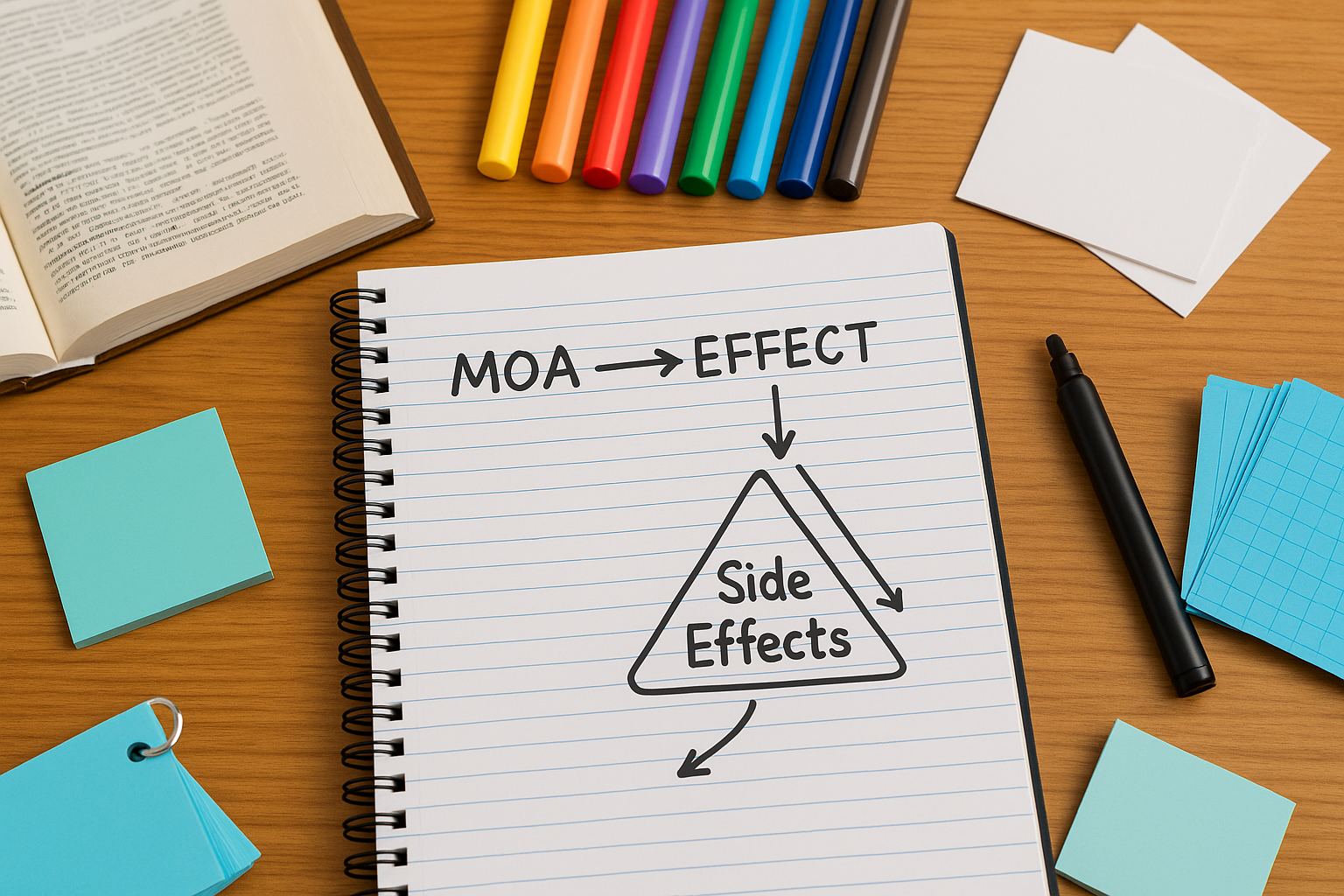ChatGPT said:
References:Why Most Pharmacology Mnemonics Fail—and What Actually Works
Most medical students rely on mnemonics early in their Step 1 prep, only to realize that half of them crumble under real exam stress. The reason lies in how the brain stores associative data: surface-level memorization fades without contextual linkage. Effective mnemonics must engage at least two encoding pathways—semantic (meaning) and visual or emotional (imagery, narrative, humor).
NBME authors test pharmacology through mechanism-based vignettes, not rote recall. For instance, they’ll describe a β-blocker patient vignette with comorbid asthma rather than ask “Which drug ends with –olol?” Thus, a good mnemonic must tie suffix patterns to physiologic mechanisms and contraindications.
Using MDSteps’ Adaptive QBank and automatic flashcard generator helps reinforce high-yield mnemonics through active recall cycles. Every missed question is auto-converted into a review card linked to pharmacologic pathways, ensuring the mnemonic is recalled in the context that Step 1 actually tests.
When constructing or choosing mnemonics, the rule is simple: if it doesn’t connect to mechanism or physiology, it won’t survive exam day.
Mechanism Mnemonics: Learning Drugs by Their Roots
Drug suffixes, prefixes, and stems encode valuable hints that NBME question writers expect you to notice. Instead of brute-forcing lists, learn to recognize pharmacologic “language.” For example, “-pril” (ACE inhibitors) links to “pressure relief,” while “-zosin” (α₁-blockers) recalls “zoning out” smooth muscle tone.
Below is a concise mnemonic table that maps mechanism to memory cue:
Drug Class Mnemonic Mechanism Link ACE Inhibitors (-pril) “April showers bring pressure flowers” Vasodilation via ↓ angiotensin II β-Blockers (-olol) “Oh LOL, slow down the heart” β₁ antagonism lowers HR & BP Ca²⁺ Channel Blockers (-dipine) “Dipping vessels” Vasodilation of smooth muscle Azoles “A-Z antifungal armor” Inhibit ergosterol synthesis Stress-Proof Mnemonics: Recall That Survives Exam Conditions
Under testing stress, working memory collapses. The mnemonics that endure are those supported by **retrieval practice and context encoding**. Repeating “funny” or “rhyming” tricks isn’t enough—students need spaced retrieval and emotional anchoring.
For example, the cholinergic toxicity phrase “DUMBELS” (Diarrhea, Urination, Miosis, Bradycardia, Emesis, Lacrimation, Salivation) persists because it’s both rhythmic and anatomically grouped. Mnemonics should match clinical patterns (e.g., “Hot as a hare, dry as a bone” for anticholinergics).
MDSteps’ readiness dashboard visualizes which mnemonic-linked question types decay over time, letting you adjust review intervals automatically. Use this data to identify “fragile mnemonics”—those you forget quickly—and strengthen them through focused retesting rather than re-memorizing lists.
Dirty Mnemonics, Clean Memory: Using Humor to Cement Concepts
Humor and exaggeration act as emotional amplifiers in long-term memory formation. While crude or “dirty” mnemonics might sound unprofessional, the emotional salience they evoke can dramatically enhance retention.
Take antibiotics: “Buy AT 30, CCELL at 50” for ribosomal inhibition (Aminoglycosides & Tetracyclines at 30S; Chloramphenicol, Clindamycin, Erythromycin, Linezolid at 50S) combines rhyme and imagery. The catchiness ensures rapid decoding on exam day.
When humor aligns with physiology—like imagining the β-blocker “carvedilol” carving out heart stress—it builds neural connections that pure repetition cannot.
The key is moderation and appropriateness. Avoid mnemonics that confuse mechanisms or contradict drug classes. MDSteps’ integrated flashcard generator lets you tag your own custom mnemonics to specific questions, personalizing humor without losing rigor.
System-Based Mnemonics: Organizing Recall by Clinical Context
Pharmacology memory sticks best when mapped to organ systems. Rather than random drug recall, think “renal agents in nephron order” or “cardiac drugs by conduction pathway.”
This grid system organizes mnemonics by physiology and mechanism:
System Mnemonic Example Concept Reinforced Cardio “Double NITRO for heart attacks” (Nitroglycerin, Isosorbide) NO-mediated vasodilation Neuro “Seize the GABA” (benzodiazepines enhance GABA) Increased inhibitory tone Renal “Loop loses calcium, Thiazide takes it in” Ionic transport differences Endocrine “Sulfa Sweets” for sulfonylureas stimulating insulin β-cell depolarization Visual Mnemonics: The Power of Imagery in Drug Recall
The brain stores visual and spatial information more efficiently than text. Imagery-based mnemonics transform abstract mechanisms into memorable scenes.
For instance, students often visualize “ACE inhibitors” as umbrellas blocking angiotensin rain or imagine “β-blockers” as shields slowing adrenaline arrows. The more bizarre and emotionally charged the imagery, the stronger the recall.
Dual coding—combining words with images—boosts recall by nearly 40% in cognitive studies. MDSteps supports this through automatic flashcard image generation: when reviewing missed questions, you can attach diagrams, icons, or personal sketches directly to the card, turning complex pharmacology into quick visual triggers.
For Step 1, visual mnemonics work best for pathways (autonomic drugs, enzyme inhibitors, signal cascades), where mechanism visualization aligns with test design.
Integrating Mnemonics Into a Long-Term Study Loop
Mnemonics are only as durable as the review cycle supporting them. The key is **spaced repetition plus retrieval practice**.
A recommended workflow:
By cycling mnemonics through test questions and context-driven recall, you move from fragile short-term memorization to durable long-term encoding. The MDSteps analytics dashboard quantifies this progression—showing which mnemonics truly “work” in live testing conditions.
Rapid-Review Checklist: Mnemonics That Stick
When used strategically, mnemonics are not shortcuts—they’re scaffolds for meaningful, high-yield learning. Step 1 success depends not on memorizing every drug, but on recognizing patterns, mechanisms, and contextual triggers embedded in NBME logic.
1. McDaniel MA et al. “Test-Enhanced Learning: The Potential for High-Stakes Exams.” *Review of Educational Research.* 2007.
2. Weinstein Y, Sumeracki M. *Understanding How We Learn: A Visual Guide.* Routledge, 2018.
3. Dunlosky J et al. “Improving Students’ Learning With Effective Learning Techniques.” *Psychological Science in the Public Interest.* 2013.
4. Karpicke JD. “Retrieval-Based Learning: Active Retrieval Promotes Meaningful Learning.” *Current Directions in Psychological Science.* 2012.
5. MDSteps Learning Science Division. “Adaptive Recall and Performance Analytics Whitepaper,” 2024.


